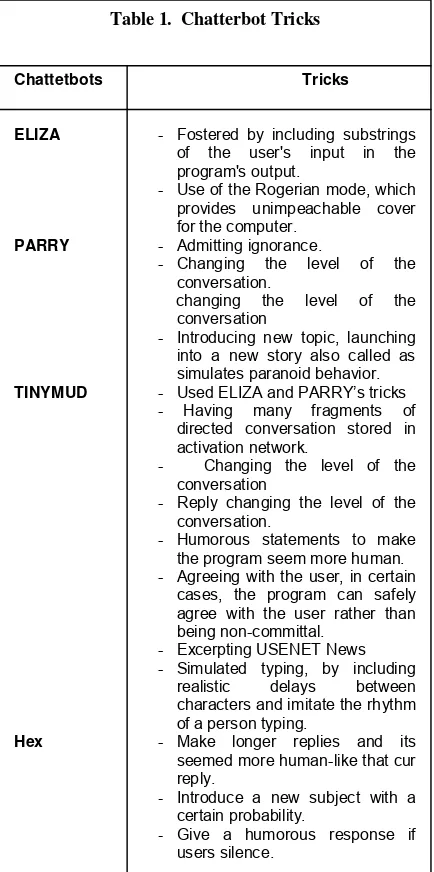Towards A More Natural and Intelligent Interface with
Embodied Conversation Agent
1
Goh Ong Sing,
2Kok Wai Wong,
3Chun Che Fung,
4Arnold Depickere,
School
of Information Technology, Division of Arts, Murdoch University, Murdoch, Western Australia
{
1os.goh,
2k.wong,
3l.fung,
4a.depickere} @murdoch.edu.au
ABSTRACT
Conversational agent also known as chatterbots are computer programs which are designed to converse like a human as much as their intelligent allows. In many ways, they are the embodiment of Turing's vision. The ability for computers to converse with human users using natural language would arguably increase their usefulness. Recent advances in Natural Language Processing (NLP) and Artificial Intelligence (AI) in general have advances this field in realizing the vision of a more humanoid interactive system. This paper presents and discusses the use of embodied conversation agent (ECA) for the imitation games. This paper also presents the technical design of our ECA and its performance. In the interactive media industry, it can also been observed that the ECA are getting popular.
Keywords
Embodied Conversational Agents (ECAs), Natural Artificial Intelligent Neural-network Identity (AINI), imitation games, Turing Test
1.
THE IMITATION GAMES
Alan Turing was a brilliant British mathematician who played a great role in the development of the computer and posed one of the most famous challenges in Computer Science. One of his most enduring contributions is a simple test he proposed in 1950 that remains one of the most debated issues in the world of artificial intelligence. Turing came up with an interesting philosophy at that time. He constructed the simple proposition that if human beings are intelligent, and if a machine can imitate a human, then the machine would have been considered intelligent. This is also known as imitation game (IG). The IG is now known as the Turing test (TT)[1], was introduced by Turing to decide whether a computer program is consider as intelligent. Turing’s aim is to provide a methodology to assess whether a machine can think like a human. He attempts to transform this into a more concrete form by proposing what was known as the IG. The game is played with three persons, a man (A), a woman (B) and an interrogator (C) who may be of either sex. The interrogator stays in a room apart from A and B. The objective of the interrogator is to determine whether person A or B is a woman. At the other end, the objective of persons A and B is to convince the interrogator that he/she is the woman and the other is not. This situation is depicted in Figure 1.
Similarly to the IG, to test for the intelligence of a computer system, the Turing test involves a computer, a human interrogator and a human foil. The interrogator attempts to differentiate the computer system by asking questions to the two participants. All communication is performed via keyboard and screen. The interrogator may ask any questions he or she likes, and the computer is permitted to do anything possible to force a wrong identification. At the same time, the human foil must help the interrogator to make a correct identification of the computer system. A number of different people play the roles of interrogator and foil, and if sufficient interrogators are unable to distinguish the computer from the human being then it can then be concluded that the computer has a certain degree of intelligence.
To decide whether the computer is intelligent we replace the question “Can the computer program think” with the question “On the average, after n minutes or m questions,
is the interrogator’s probability of correctly identifying the subjects not significantly greater then 50 percent?”[2]
Alan Turing died in 1954, a decade before computer programs such as ELIZA began to proliferate. It is indeed unfortunate that he did not live to see and analyze such programs. Although ELIZA is constructed with the aim to pass the Turing test, but may researchers found that it is
Figure 1. The Imitation Game
far from it. Over the years, researchers thought it is obvious that no modern machine could yet pass the Turing test. In 1990, Hugh Loebner agreed with The Cambridge Center for Behavioral Studies to underwrite a contest designed to implement the Turing Test[3]. Dr. Loebner pledged a Grand Prize of $100,000 and a Gold Medal for the first computer whose responses were indistinguishable from a human's. Such a computer can be considered to have the ability "to think". Each year an annual prize of $2000 and a bronze medal is awarded to the most human-like computer. The winner of the annual contest is the best entry relative to other entries in that year, irrespective of how good it is in an absolute sense [4].
2. TRICKS VS AI
Some people interpret the TT as a setting in which you can "cheat". The game has no rules constraining the design of the machines. Turing describes how machines could be "rigged" to overcome certain obstacles proposed by opponents of the idea that machines can think. An obvious example is about machines making mistakes. When the machine is faced with an arithmetical challenge, in order not to give away its identity of being fast and accurate, it can pause for about 30 seconds before responding and occasionally give a wrong answer. Being able to carry out arithmetical calculations fast and accurately is generally considered intelligent behavior. However, Turing wishes to sacrifice this at the expense of human-ness. Some commentators think this is "cheating". The machine is resorting to certain "tricks" in its operations rather than imitating the human ways. However, arithmetic is a highly specific domain. Modifying the programs in this manner cannot hurt: If a machine can pass the test, it can then be re-programmed not to cheat at arithmetic. If it does not resort to this, the interrogator can ask a difficult arithmetical problem as his/her first question and decide that he/she is dealing with a machine right then and there. We believe the best way to handle this issue is considering this as "deception" rather than as "cheating". After all, in a way, the game is all about deception. It can be seen that Turing considers it possible that a sufficiently human-like machine (i.e., a machine that is sufficiently good at playing the IG is bound to make such mistakes as we attribute to humans.
The Turing test in general and the Loebner prize in particular reward tricks, and the winning programs for the last fifteen years have clearly had some tricks. Shieber has criticized the Loebner competition as rewarding tricks [5]. This sort of qualitative assessment to program knowledge is exactly what the Turing test trying to avoid, replacing the question ``Can machines think?'' with a performance test. Turing’s imitation game is generally inadequate as a test of intelligence, as it relies solely on the ability to fool people. This can be achieved easily, as Weizenbaum has found [2]. Here we describe some of the better tricks, confident in the belief that when someday a computer program does pass the Turing test, it will use many of them. There is also a simple reason for this as people are already using them in everyday life. The Loebner contest may just stimulate a few advances in the field of natural language interfaces to database engines.
After all, the chatterbots has already fools ``average'' questioners. If a larger collection of ``tricks'' sufficed, would you redefine ``artificial intelligence,'' ``average questioner,'' or ``trick?'' Perhaps the biggest obstacle to the advancing in this area is there are not many uses for fooling people besides the Turing test [6]
Fifteen years after Turing proposed the imitation game, Weizenbaum's ELIZA program demonstrated that ``a simple computer program'' could successfully play the imitation game by resorting to a few ``tricks,'' the most obvious being to answer questions with questions[7]. The
others chatterbots such as PARRY, TINYMUD and Hex also have their own tricks as depicted in the Table 1
4. ECA A NEW CHALLENGE
During the past decade, one can observed that there are rapid advances in embodied conversational agent (ECA),
Table 1. Chatterbot Tricks
PARRY - Admitting ignorance.
- Changing the level of the

